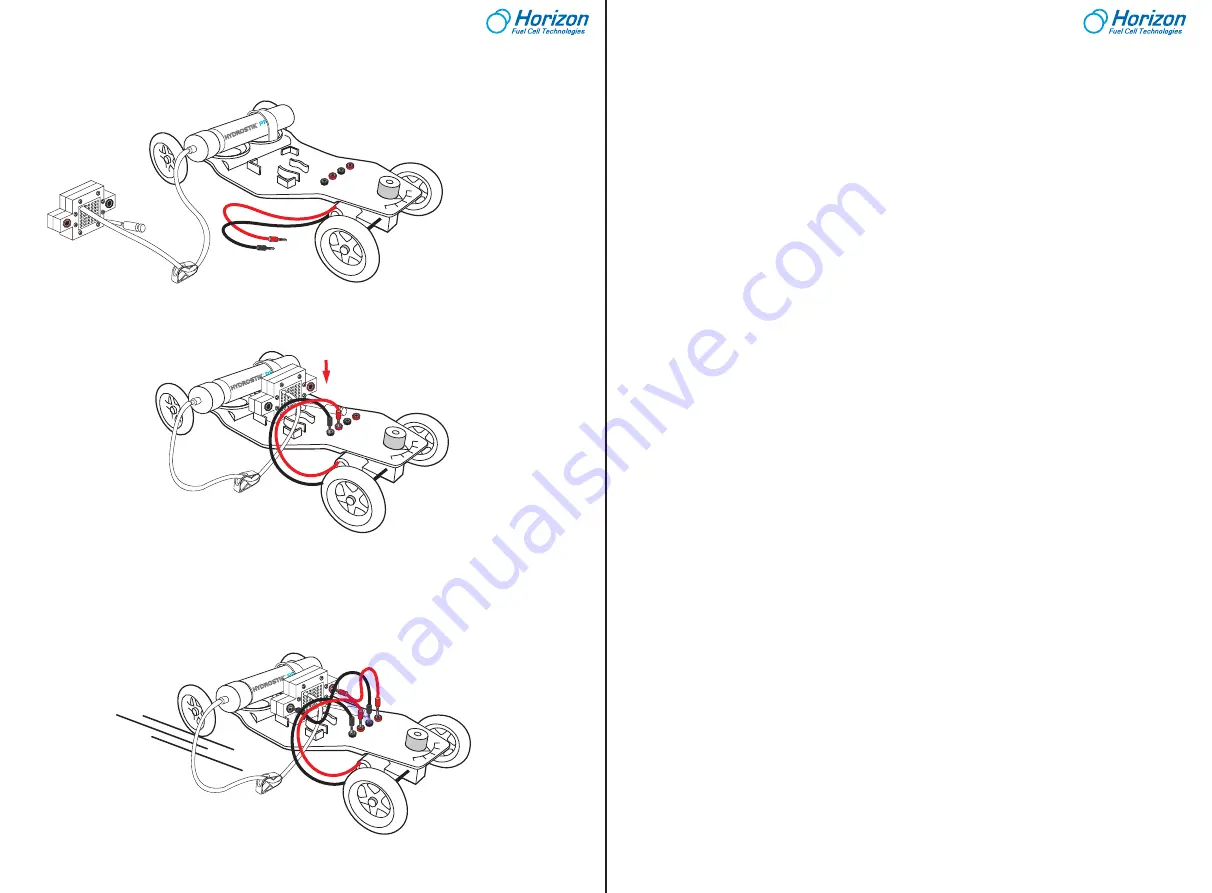
Step 5. Connect the other end of the pressure regulator tube to the fuel cell higher nozzle (close to the red
plug). Then lightly screw the pressure regulator to the HYDROSTIK PRO. Stop to screw as soon as both
parts fit together.
Step 6. After this place the mini fuel cell on the slot located on the car frame top. Ensure they fit well.
Then connect the car engine wires into its plugs.
Step 7. Connect the two wires to the red and black plugs on the car frame. Connect the other end to the
fuel cell.
Step 8. Open the clamp and finish to screw the pressure regulator to the mini fuel cell. Press the purging
valve for two seconds and let a small amount of hydrogen pass through the mini fuel cell.
The car will start to run.
Troubleshooting
1. The car does not run after the HYDROSTIK PRO supplies hydrogen to the fuel cell.
Solution: a. The car may need to be flicked with your finger to start.
b. Recharge the HYDROSTIK PRO fully.
c. Press the purging valve to purge a little bit amount of hydrogen out of the system.
d. Make sure the HYDROSTIK PRO is connected to the pressure regulator tightly.
2. The car runs slower than before.
Solution: a. Recharge the HYDROSTIK PRO fully.
b. Press the purging valve to purge a little bit amount of hydrogen out of the system.
61
62
Hydrogen: Fuel of the Future
Hydrogen offers the promise of a sustainable energ source for the future of transportation, and the
potential to greatly reduce CO2 emissions. Hydrogen is the most commonly occurring element in the
universe. It is a colorless, odorless, non-poisonous gas that is lighter than air. Hydrogen is one of the
most important alternative fuels for the future, because it has the ability to replace all the fossil fuels
used on the road today, and thus to reduce greenhouse gas emissions. The governments of
countries around the world see the promise of hydrogen and are investing billions of dollars in
research and development for hydrogen energy technologies. The U.S. Department of Energy has a
Hydrogen Program that is working with industry, schools, laboratories, and other government
agencies to overcome the obstacles standing in the way of widespread fuel cell adoption. They are
addressing issues in hydrogen production, delivery, storage, safety, and fuel cell technology itself.
According to HyWays, a research project funded by the European Union, building ahydrogen
infrastructure in Europe would allow for a reduction in CO2 emissions from automobile transportation
of over 50 percent by 2050, and it could be done in an economically acceptable manner. A critical
hurdle for the use of this innovative fuel that must be overcome is the distribution of hydrogen to
individual automobiles. A large network of hydrogen fueling stations would need to be installed, just
like our current network of gasoline fueling stations. This is only economically viable and feasible as a
large-scale effort. Strong joint efforts from all of the stakeholders in both the public and private
sectors is crucial to the successful adoption of hydrogen technology.
The Significance of the Fuel Cell
The fuel cell can play an important role as we change the way we meet our energy needs. It has a
range of advantages:
1. It provides electricity in a more efficient manner than conventional power plants, which obtain
electricity on a “detour” from chemically-produced heat energy through mechanical
to electrical energy. The fuel cell, by contrast, creates electricity directly from chemical reaction
energy (by “cold” combustion). So it has a significantly greater degree of efficiency
than conventional types of energy conversion (with the exception of gas turbine power plants).
2. The fuel, which is hydrogen or other gases, can be obtained from renewable energy sources.
3. It is clean, since instead of climate-harmful CO2, the only “waste” it releases is water vapor. Also, it
is quiet.
4. Special fuel cells can be conveniently used in the cellar of a house as miniature off-grid residential
heating and power units. In addition to electricity, they also give off plenty of heat from their gaseous
fuel and the surrounding







































